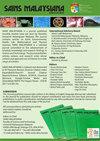Methods of Evaluating Adaptation and Accuracy of Additive Manufactured Removable Partial Dentures: A Scoping Review
IF 0.7
4区 综合性期刊
Q3 MULTIDISCIPLINARY SCIENCES
引用次数: 0
Abstract
This study aimed to provide a comprehensive review of various recent methods that can be used to assess the fit and accuracy of additive-manufactured removable partial dentures (RPDs), focusing on 3D-printed RPDs. An electronic search of the English language literature from January 2000 to February 2022 was performed using four databases: Medline/PubMed, Scopus, Web of Science, and EBSCOhost, using relevant keywords. The parameters of interest were extracted and tabulated. Of 936 retrieved studies, 26 studies were included. Most of the studies were laboratory studies, conducted between 2011 and 2022, did not include control group, used stone cast model as reference, used direct 3D printing method, and polished the final RPD framework. Methods of assessment can be divided into two categories: 1) qualitative assessment which is based mainly on visual inspection or tactile sense, and 2) quantitative assessment which includes optical assessment (with or without a registration material) and computerized assessment based on surface-matching software programs. In conclusion, computerized assessment using different surface matching software provides more accurate and precise quantitative assessment of denture fit and allows researcher and practitioner to detect minute dimensional changes that cannot be detected visually.评价增材制造可摘局部义齿的适应性和准确性的方法:范围综述
本研究旨在全面回顾各种最新方法,可用于评估增材制造可摘局部义齿(rpd)的适合性和准确性,重点是3d打印的可摘局部义齿。利用Medline/PubMed、Scopus、Web of Science和EBSCOhost四个数据库,使用相关关键词对2000年1月至2022年2月的英文文献进行电子检索。提取感兴趣的参数并制成表格。在936项被检索的研究中,纳入了26项研究。大多数研究是在2011年至2022年间进行的实验室研究,不包括对照组,使用石铸模型作为参考,使用直接3D打印方法,并抛光最终的RPD框架。评估方法可分为两大类:定性评估,主要基于视觉检查或触觉;定量评估,包括光学评估(有或没有注册材料)和基于表面匹配软件程序的计算机评估。总之,使用不同表面匹配软件的计算机化评估提供了更准确和精确的义齿贴合定量评估,并允许研究人员和从业者检测肉眼无法检测到的微小尺寸变化。
本文章由计算机程序翻译,如有差异,请以英文原文为准。
求助全文
约1分钟内获得全文
求助全文
来源期刊

Sains Malaysiana
MULTIDISCIPLINARY SCIENCES-
CiteScore
1.60
自引率
12.50%
发文量
196
审稿时长
3-6 weeks
期刊介绍:
Sains Malaysiana is a refereed journal committed to the advancement of scholarly knowledge and research findings of the several branches of science and technology. It contains articles on Earth Sciences, Health Sciences, Life Sciences, Mathematical Sciences and Physical Sciences. The journal publishes articles, reviews, and research notes whose content and approach are of interest to a wide range of scholars. Sains Malaysiana is published by the UKM Press an its autonomous Editorial Board are drawn from the Faculty of Science and Technology, Universiti Kebangsaan Malaysia. In addition, distinguished scholars from local and foreign universities are appointed to serve as advisory board members and referees.
 求助内容:
求助内容: 应助结果提醒方式:
应助结果提醒方式:


